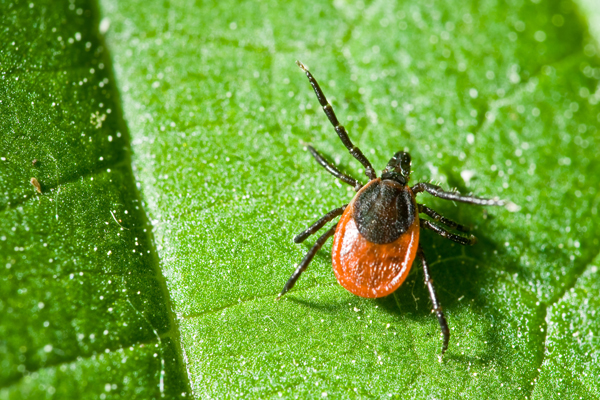
In 2016, more than 200 cases of Lyme disease were reported in Michigan. Lyme disease is caused by the bacteria Borrelia burgdorferi, which is carried by Deer ticks, and is the most common tick-borne illness in the U.S.
Two different types of ticks make up over 90% of the tick population in Michigan: the American dog tick (75%); and the Black-legged tick, or more widely known as the Deer tick, (15%).
What’s all the fuss?
The symptoms of Lyme disease are wide ranging and can include a rash, flu-like symptoms, joint pain, muscle pain, heart problems and neurologic symptoms, and can progress through several stages, even years after being infected.
Stage 1: Erythema migrans rash (bulls-eye rash) occurs in about 80% of those infected with the bacteria. The rash typically appears in 3-10 days but can appear up to 30 days after exposure.
Stage 2: Weakness, facial paralysis, flu-like symptoms, joint and muscle aches can occur weeks to months after exposure.
Stage 3: Muscle and joint pains, speech and memory issues and neurological problems can occur months to years after exposure.
How do I recognize a Deer tick?
About the size of a poppy seed and difficult to spot, the nymph stage of the Deer tick poses the greatest risk for an undetected bite and exposure. Adult female Deer ticks (pictured above) are about the size of a sesame seed. Adult males do not bite. Deer ticks have eight legs and are a solid reddish brown to dark brown color with no markings and do not jump or fly. Risk for tick bites start in early spring and through early fall.
How can I protect myself from Lyme disease?
Although a little scary to think about, Lyme disease is pretty difficult to get, and there is good treatment for it if caught early. Ticks are carried by rodents, birds and deer, primarily. They avail themselves to latching on to a host in natural grassy and sandy areas or leafy debris of a forest floor, which makes the entire west coast of Michigan a habitat for the Black-legged (Deer) tick. They do not thrive in hot open areas or grass lawns. Avoiding zones where ticks are known to be is most useful, but when heading into areas where ticks may live, these tips will be helpful at preventing an exposure to Lyme disease;
- Stay on the established trails when hiking.
- Wear long pants and tuck them into your socks.
- Wear light colored clothes to make it easier to spot a tick and remove it.
- Apply repellant containing DEET before entering a natural area. (Applying permethrin to your clothes (not your skin) is very effective at killing ticks and remains effective through several launderings.)
- Shower after being in a natural area and check your body for ticks and remove them promptly. Note: Prime areas on the body that ticks tend to bite for a blood meal are the armpits, waist line, behind the knees and around the hairline line but could latch on anywhere.
- Treat your pets with an appropriate tick repellent.
How do I remove a tick?
Using blunt tweezers or protected fingers, grasp the tick at the skin surface and with steady pressure, pull upward. Do not twist or jerk the tick. Tick removal devices are also available at sporting goods stores.Thoroughly wash the skin with soap; an antibiotic ointment may be applied. Do not try to remove retained mouth parts. The body will expel these over time and they should not be “dug” out with a needle. Do not cover the tick with Vaseline, nail polish remover or other chemical. Do not try to burn it out with a hot match.
When should I see a Healthcare professional?
- If you think you have an erythema migrans “bulls-eye rash” seek immediate evaluation, as this finding would warrant full treatment with medication. (Taking pictures of the tick or a rash can be helpful).
- If you find an engorged tick that may have been attached for 36 hrs or longer, you should be evaluated within 72 hrs of this exposure. Bring the tick with you if it was attached and engorged for 36 hrs or longer so it can be identified.
- If you develop a rash, fever, flu-like symptoms, unexplained joint or muscle aches several weeks after a tick bite.
- A localized reaction at the site of a tick bite usually resolves in 24-48 hrs. If you develop redness, swelling and pain at the location of a tick bite lasting longer than this; you may have a secondary infection and should be evaluated.
Should I freak out and never go outside?
Absolutely not! Taking the recommended precautions considerable reduces the risk of getting a tick-borne illness such as Lyme disease. Just be informed, apply the recommended precautions and enjoy Michigan’s great outdoors!
Kenneth Hite, PA-C